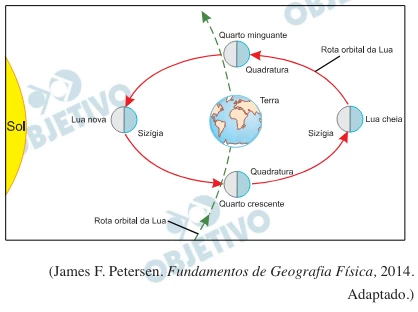FGV
Exibindo questões de 101 a 200.
Um quadrado de dimensões microscópicas tem área igual a 1,6 - FGV 2020
Matemática - 2020Um quadrado de dimensões microscópicas tem área igual a 1,6 × 10–10 m2. Sendo log 2 = m e log 5 = n, a medida do lado desse quadrado, em metro,
As bandeiras dos cinco países do Mercosul serão hasteadas - FGV 2020
Matemática - 2020As bandeiras dos cinco países do Mercosul serão hasteadas em dois postes, um verde e um amarelo. As cinco bandeiras devem ser hasteadas e cada poste deve ter pelo menos uma bandeira. Constituem situações diferentes de hasteamento a troca de ordem das bandeiras em um mesmo poste e a troca das cores dos mastros associadas a cada configuração.

Ana, Bia, Cléo, Dani, Érica e Fabi se sentam ao redor de um - FGV 2020
Matemática - 2020Ana, Bia, Cléo, Dani, Érica e Fabi se sentam ao redor de uma mesa circular, como se estivessem nos vértices de um hexágono regular inscrito na circunferência da mesa. A respeito de suas posições, sabe-se que:
• Bia está imediatamente ao lado de Cléo e diametralmente oposta a Ana;
• Dani não está sentada imediatamente ao lado de Ana.
Sendo x um número real, o operador é igual a . Esse operado - FGV 2020
Matemática - 2020Sendo x um número real, o operador X é igual a Esse operador também admite composições como, por exemplo, -1 = 5. De acordo com a definição do operador, o valor de
Esse operador também admite composições como, por exemplo, -1 = 5. De acordo com a definição do operador, o valor de
A figura indica o triângulo FGV, no plano cartesiano de - FGV 2020
Matemática - 2020A figura indica o triângulo FGV, no plano cartesiano de eixos ortogonais, e as coordenadas dos seus vértices.

Considere a matriz quadrada A = (aij)2×2, com aij = . Sendo - FGV 2020
Matemática - 2020Considere a matriz quadrada A = (aij)2×2, com
A soma das duas raízes não reais da equação algébrica x3 + - FGV 2020
Matemática - 2020A soma das duas raízes não reais da equação algébrica x3 + 2x2 + 3x + 2 = 0, resolvida em C,
Admita que uma notícia, consultada na internet, tenha vindo - FGV 2020
Matemática - 2020Admita que uma notícia, consultada na internet, tenha vindo com um X no lugar de um gráfico, como indica a imagem a seguir

Sendo m e n números reais não nulos, um dos fatores do - FGV 2020
Matemática - 2020Sendo m e n números reais não nulos, um dos fatores do polinômio P(x) = mx2 – nx + m é (3x – 2).
Seja FGV um triângulo isósceles, desenhado no plano - FGV 2020
Matemática - 2020Seja FGV um triângulo isósceles, desenhado no plano cartesiano de eixos ortogonais, com FG = GV = 5 e FV = 6, vértice F coincidindo com a origem dos eixos, FV contido no eixo x e ângulos internos, em radianos, como mostra a figura 1.


Uma urna contém 11 fichas idênticas, marcadas com os número - FGV 2020
Matemática - 2020Uma urna contém 11 fichas idênticas, marcadas com os números 2, 2, 3, 4, 5, 5, 5, 6, 7, 8 e 9. Retiram-se ao acaso duas fichas e denota-se o produto dos números obtidos por P. Em seguida, sem reposição, retira-se ao acaso mais uma ficha e denota-se o número obtido por N.
O valor máximo da função real dada por é igual a a) –2 - FGV 2020
Matemática - 2020O valor máximo da função real dada por
A figura indica os gráficos das funções reais definidas por - FGV 2020
Matemática - 2020A figura indica os gráficos das funções reais definidas por y = –1 + 2cos (2x) e y + 1 + √3 = 0 no plano cartesiano de eixos ortogonais, sendo P um dos pontos de intersecção dos gráficos.

Sendo k um número real, o conjunto de todos os valores - FGV 2020
Matemática - 2020Sendo k um número real, o conjunto de todos os valores reais de k para os quais o sistema de equações 
A figura indica um cone reto de revolução de vértice V, - FGV 2020
Matemática - 2020A figura indica um cone reto de revolução de vértice V, altura VC e diâmetro da base AB. O ponto M pertence à geratriz VP do cone, AMB é um triângulo de área igual a 3√3 cm2, VC = BM, CM = CA = CB = MV = MP e o ângulo A ^ MB é reto.

ABCD e A'B'C'D' são faces de dois paralelepípedos - FGV 2020
Matemática - 2020ABCD e A'B'C'D' são faces de dois paralelepípedos retoretangulares que estão encostados de forma que duas arestas do menor estão totalmente contidas em duas arestas do maior, como mostra a figura. Além das medidas indicadas na figura, sabe-se que:
Além das medidas indicadas na figura, sabe-se que:
• P e Q pertencem a CD e A’B’, respectivamente;
• PQ é perpendicular a A’B’;
• RCB’C’ e RPQC’ são retângulos.
Em certo dia, a cotação da libra esterlina em Nova Iorque - FGV 2020
Matemática - 2020Em certo dia, a cotação da libra esterlina em Nova Iorque era de 1,25 dólar americano por 1,00 libra, e a cotação de 1,00 dólar americano era de 4,10 reais. Nesse mesmo dia, em Londres, 1,00 libra era cotada a 5,09 reais e 1 dólar americano era cotado a 4,15 reais. Bianca e Carolina compraram, nesse mesmo dia, 415 libras cada uma.
Com a finalidade de fazer uma reserva financeira para usar - FGV 2020
Matemática - 2020Com a finalidade de fazer uma reserva financeira para usar daqui a 10 anos, Luís planejou o seguinte investimento: depositar no mês 1 a quantia de R$ 500,00 e, em cada mês subsequente, depositar uma quantia 0,4% superior ao depósito do mês anterior, em uma aplicação financeira que rende 0,5% ao mês, capitalizado mensalmente.
Para que o preço atual de um produto ficasse igual ao preço - FGV 2020
Matemática - 2020Para que o preço atual de um produto ficasse igual ao preço dele 5 anos atrás, seria necessário dar um desconto de 60%. Sabendo-se que a média entre o preço atual desse produto e o preço praticado há 5 anos é igual a R$ 168,00,
Um polígono regular de x lados está perfeitamente cercado - FGV 2020
Matemática - 2020Um polígono regular de x lados está perfeitamente cercado por polígonos regulares idênticos de y lados, sem sobreposições ou espaços livres. Por exemplo, a figura mostra a situação descrita para o caso em que x = 4 e y = 8.

Considere a equação 10z2 – 2iz – k = 0, em que z é um - FGV 2020
Matemática - 2020Considere a equação 10z2 – 2iz – k = 0, em que z é um número complexo e i2 = –1.
Uma moeda não honesta tem probabilidade igual a - FGV 2020
Matemática - 2020Uma moeda não honesta tem probabilidade igual a 2/3 de sair cara, contra 1/3 de sair coroa. Lançando-se essa moeda 20 vezes,
Na figura, FECO é um trapézio isósceles, com FE = OC = 5 cm - FGV 2020
Matemática - 2020Na figura, FECO é um trapézio isósceles, com FE = OC = 5 cm, EC = 4 cm e FO = 10 cm, e FGV é um triângulo retângulo com ângulo reto em V, com C em FG e O em FV.

Uma urna contém de bolas brancas e de bolas pretas, sendo - FGV 2020
Matemática - 2020Uma urna contém 2/3 de bolas brancas e 1/3 de bolas pretas, sendo que somente metade das bolas brancas e 2/3 das bolas pretas contêm um prêmio em seu interior. Uma bola dessa urna é sorteada aleatoriamente e, quando aberta, verifica-se que tem um prêmio no seu interior.
Uma amostra de cinco número inteiros não negativos, que - FGV 2020
Matemática - 2020Uma amostra de cinco número inteiros não negativos, que pode apresentar números repetidos, possui média igual a 10 e mediana igual a 12.
Atualmente, o preço de uma mercadoria é 20% superior ao que - FGV 2020
Matemática - 2020Atualmente, o preço de uma mercadoria é 20% superior ao que era há um ano. Sabe-se também que o preço atual é 10% superior ao preço da mercadoria na época em que ela custava R$ 100,00 a menos do que hoje.
Uma formiga desloca-se sobre uma malha quadriculada com - FGV 2020
Matemática - 2020Uma formiga desloca-se sobre uma malha quadriculada com eixos cartesianos ortogonais. Ela parte do ponto de coordenadas (0, 0) e segue um caminho conforme o padrão indicado na figura.

A figura indica uma configuração retangular feita com - FGV 2020
Matemática - 2020A figura indica uma configuração retangular feita com palitos idênticos.

O planeta que está ficando cada vez mais desigual. Nos - FGV 2022
Geografia - 2020O planeta que está ficando cada vez mais desigual. Nos últimos 40 anos, a concentração de renda só cresceu com a globalização. Tanto é assim que atualmente nenhum país tem maior desigualdade que a África do Sul. O país, por ironia, viu crescer a desigualdade após o fim do Apartheid.
Na oração “— Traduzo coisa nenhuma” (5.o parágrafo), o term - FGV 2020
Língua Portuguesa - 2020Leia o texto para responder
Modos de xingar
— Biltre!
— O quê?
— Biltre! Sacripanta!
— Traduz isso para português.
— Traduzo coisa nenhuma. Além do mais, charro!
Onagro!
Parei para escutar. As palavras estranhas jorravam do interior de um Ford de bigode. Quem as proferia era um senhor idoso, terno escuro, fisionomia respeitável, alterada pela indignação. Quem as recebia era um garotão de camisa esporte; dentes clarinhos emergindo da floresta capilar, no interior de um fusca. Desses casos de toda hora: o fusca bateu no Ford. Discussão. Bate-boca. O velho usava o repertório de xingamentos de seu tempo e de sua condição: professor, quem sabe? leitor de Camilo Castelo Branco.
Os velhos xingamentos. Pessoas havia que se recusavam a usar o trivial das ruas e botequins, e iam pedir a Rui Barbosa, aos mestres da língua, expressões que castigassem fortemente o adversário. Esse material seleto vinha esmaltar artigos de polêmica (polemizava-se muito nos jornais do começo do século), discursos políticos (nos intervalos do estado de sítio, é lógico) e um pouco os incidentes de calçada. A maioria, sem dúvida, não se empenhava em requintes.
(Carlos Drummond de Andrade. “Modos de xingar”.
As palavras que ninguém diz, 2011.)
A frase do último parágrafo do texto “A maioria, sem dúvida - FGV 2020
Língua Portuguesa - 2020Leia o texto para responder
Modos de xingar
— Biltre!
— O quê?
— Biltre! Sacripanta!
— Traduz isso para português.
— Traduzo coisa nenhuma. Além do mais, charro!
Onagro!
Parei para escutar. As palavras estranhas jorravam do interior de um Ford de bigode. Quem as proferia era um senhor idoso, terno escuro, fisionomia respeitável, alterada pela indignação. Quem as recebia era um garotão de camisa esporte; dentes clarinhos emergindo da floresta capilar, no interior de um fusca. Desses casos de toda hora: o fusca bateu no Ford. Discussão. Bate-boca. O velho usava o repertório de xingamentos de seu tempo e de sua condição: professor, quem sabe? leitor de Camilo Castelo Branco.
Os velhos xingamentos. Pessoas havia que se recusavam a usar o trivial das ruas e botequins, e iam pedir a Rui Barbosa, aos mestres da língua, expressões que castigassem fortemente o adversário. Esse material seleto vinha esmaltar artigos de polêmica (polemizava-se muito nos jornais do começo do século), discursos políticos (nos intervalos do estado de sítio, é lógico) e um pouco os incidentes de calçada. A maioria, sem dúvida, não se empenhava em requintes.
(Carlos Drummond de Andrade. “Modos de xingar”.
As palavras que ninguém diz, 2011.)
Analisando-se os modos de organização do texto, conclui-se - FGV 2020
Língua Portuguesa - 2020Leia o texto para responder
Modos de xingar
— Biltre!
— O quê?
— Biltre! Sacripanta!
— Traduz isso para português.
— Traduzo coisa nenhuma. Além do mais, charro!
Onagro!
Parei para escutar. As palavras estranhas jorravam do interior de um Ford de bigode. Quem as proferia era um senhor idoso, terno escuro, fisionomia respeitável, alterada pela indignação. Quem as recebia era um garotão de camisa esporte; dentes clarinhos emergindo da floresta capilar, no interior de um fusca. Desses casos de toda hora: o fusca bateu no Ford. Discussão. Bate-boca. O velho usava o repertório de xingamentos de seu tempo e de sua condição: professor, quem sabe? leitor de Camilo Castelo Branco.
Os velhos xingamentos. Pessoas havia que se recusavam a usar o trivial das ruas e botequins, e iam pedir a Rui Barbosa, aos mestres da língua, expressões que castigassem fortemente o adversário. Esse material seleto vinha esmaltar artigos de polêmica (polemizava-se muito nos jornais do começo do século), discursos políticos (nos intervalos do estado de sítio, é lógico) e um pouco os incidentes de calçada. A maioria, sem dúvida, não se empenhava em requintes.
(Carlos Drummond de Andrade. “Modos de xingar”.
As palavras que ninguém diz, 2011.)
As passagens “— O quê?” (2.o parágrafo) e “professor, quem - FGV 2020
Língua Portuguesa - 2020Leia o texto para responder
Modos de xingar
— Biltre!
— O quê?
— Biltre! Sacripanta!
— Traduz isso para português.
— Traduzo coisa nenhuma. Além do mais, charro!
Onagro!
Parei para escutar. As palavras estranhas jorravam do interior de um Ford de bigode. Quem as proferia era um senhor idoso, terno escuro, fisionomia respeitável, alterada pela indignação. Quem as recebia era um garotão de camisa esporte; dentes clarinhos emergindo da floresta capilar, no interior de um fusca. Desses casos de toda hora: o fusca bateu no Ford. Discussão. Bate-boca. O velho usava o repertório de xingamentos de seu tempo e de sua condição: professor, quem sabe? leitor de Camilo Castelo Branco.
Os velhos xingamentos. Pessoas havia que se recusavam a usar o trivial das ruas e botequins, e iam pedir a Rui Barbosa, aos mestres da língua, expressões que castigassem fortemente o adversário. Esse material seleto vinha esmaltar artigos de polêmica (polemizava-se muito nos jornais do começo do século), discursos políticos (nos intervalos do estado de sítio, é lógico) e um pouco os incidentes de calçada. A maioria, sem dúvida, não se empenhava em requintes.
(Carlos Drummond de Andrade. “Modos de xingar”.
As palavras que ninguém diz, 2011.)
Nas frases “E outra que ele come para digerir de novo” e “ - FGV 2020
Língua Portuguesa - 2020Leia a tira Níquel Náusea, de Fernando Gonsales.

Nas expressões “cientistas exasperados”, “exemplar da - FGV 2020
Língua Portuguesa - 2020Leia o texto para responder
Nos dois primeiros episódios da série Chernobyl, da HBO, cientistas exasperados tentam convencer os superiores na usina e no governo soviético de que um dos reatores nucleares explodiu e está jorrando radioatividade sobre a Europa.
A resposta dos superiores, exemplar da estupidez surrealista de uma burocracia totalitária, é sempre a mesma: impossível, um “reator RBMK não explode”. A posição oficial é que havia somente um pequeno incêndio no telhado.
“Eu fui lá, eu vi!”, repetem os cientistas, um após o outro, antes de vomitarem, verterem sangue pelos poros ou caírem duros. Apenas quando a radioatividade é detectada na Suécia, Mikhail Gorbatchov encara seus ministros com uma expressão de “camarada, deu ruim...” — naquela altura, a radioatividade liberada já era superior à de vinte bombas de Hiroshima.
Só mesmo no totalitarismo soviético, pensei, assistindo à série. Então fui ler na revista Piauí o trecho do livro A Terra inabitável: uma história do futuro, do jornalista David Wallace-Wells, que sairá pela Companhia das Letras no mês que vem. Impossível terminar as 11 páginas sobre o aquecimento global sem ficar apavorado feito um cientista em Chernobyl.
(Antonio Prata. “Bem-vindos a Chernobyl”.
www.folha.uol.com.br, 16.06.2019. Adaptado.)
Considere as passagens do texto: • [...] impossível, um - FGV 2020
Língua Portuguesa - 2020Leia o texto para responder
Nos dois primeiros episódios da série Chernobyl, da HBO, cientistas exasperados tentam convencer os superiores na usina e no governo soviético de que um dos reatores nucleares explodiu e está jorrando radioatividade sobre a Europa.
A resposta dos superiores, exemplar da estupidez surrealista de uma burocracia totalitária, é sempre a mesma: impossível, um “reator RBMK não explode”. A posição oficial é que havia somente um pequeno incêndio no telhado.
“Eu fui lá, eu vi!”, repetem os cientistas, um após o outro, antes de vomitarem, verterem sangue pelos poros ou caírem duros. Apenas quando a radioatividade é detectada na Suécia, Mikhail Gorbatchov encara seus ministros com uma expressão de “camarada, deu ruim...” — naquela altura, a radioatividade liberada já era superior à de vinte bombas de Hiroshima.
Só mesmo no totalitarismo soviético, pensei, assistindo à série. Então fui ler na revista Piauí o trecho do livro A Terra inabitável: uma história do futuro, do jornalista David Wallace-Wells, que sairá pela Companhia das Letras no mês que vem. Impossível terminar as 11 páginas sobre o aquecimento global sem ficar apavorado feito um cientista em Chernobyl.
(Antonio Prata. “Bem-vindos a Chernobyl”.
www.folha.uol.com.br, 16.06.2019. Adaptado.)
No texto, a variedade formal da língua, flagrada na - FGV 2020
Língua Portuguesa - 2020Leia o texto para responder
Nos dois primeiros episódios da série Chernobyl, da HBO, cientistas exasperados tentam convencer os superiores na usina e no governo soviético de que um dos reatores nucleares explodiu e está jorrando radioatividade sobre a Europa.
A resposta dos superiores, exemplar da estupidez surrealista de uma burocracia totalitária, é sempre a mesma: impossível, um “reator RBMK não explode”. A posição oficial é que havia somente um pequeno incêndio no telhado.
“Eu fui lá, eu vi!”, repetem os cientistas, um após o outro, antes de vomitarem, verterem sangue pelos poros ou caírem duros. Apenas quando a radioatividade é detectada na Suécia, Mikhail Gorbatchov encara seus ministros com uma expressão de “camarada, deu ruim...” — naquela altura, a radioatividade liberada já era superior à de vinte bombas de Hiroshima.
Só mesmo no totalitarismo soviético, pensei, assistindo à série. Então fui ler na revista Piauí o trecho do livro A Terra inabitável: uma história do futuro, do jornalista David Wallace-Wells, que sairá pela Companhia das Letras no mês que vem. Impossível terminar as 11 páginas sobre o aquecimento global sem ficar apavorado feito um cientista em Chernobyl.
(Antonio Prata. “Bem-vindos a Chernobyl”.
www.folha.uol.com.br, 16.06.2019. Adaptado.)
Nas passagens do texto da Exame “focos de incêndio floresta - FGV 2020
Língua Portuguesa - 2020Leia um trecho da letra da canção “Amazônia”, de Roberto Carlos, para responder
Amazônia
A lei do machado
Avalanches de desatinos
Numa ambição desmedida
Absurdos contra os destinos
De tantas fontes de vida
Quanta falta de juízo
Tolices fatais
Quem desmata, mata
Não sabe o que faz
Como dormir e sonhar
Quando a fumaça no ar
Arde nos olhos de quem pode ver
Terríveis sinais, de alerta, desperta
Pra selva viver
Amazônia, insônia do mundo
Amazônia, insônia do mundo
(www.vagalume.com.br)
Os versos “Avalanches de desatinos / Numa ambição desmedida - FGV 2020
Língua Portuguesa - 2020Leia um trecho da letra da canção “Amazônia”, de Roberto Carlos, para responder
Amazônia
A lei do machado
Avalanches de desatinos
Numa ambição desmedida
Absurdos contra os destinos
De tantas fontes de vida
Quanta falta de juízo
Tolices fatais
Quem desmata, mata
Não sabe o que faz
Como dormir e sonhar
Quando a fumaça no ar
Arde nos olhos de quem pode ver
Terríveis sinais, de alerta, desperta
Pra selva viver
Amazônia, insônia do mundo
Amazônia, insônia do mundo
(www.vagalume.com.br)
No período do quarto parágrafo “O que causa estranheza aos - FGV 2020
Língua Portuguesa - 2020Leia o texto para responder
São Paulo – Os olhos do Brasil e do mundo se voltam para a maior floresta tropical e maior reserva de biodiversidade da Terra. Milhares de mensagens de alerta em diferentes línguas circulam nas redes sociais com a hashtag #PrayForAmazonia. A razão não poderia ser pior: a Amazônia arde em chamas.
O bioma é o mais afetado pela maior onda de incêndios florestais no Brasil em sete anos. Não há novidade no fenômeno em si. A Amazônia sempre sofreu com queimadas ligadas à exploração de terra. Mas como isso chegou tão longe? Segundo dados do Inpe, o número de focos de incêndio florestal aumentou 83% entre janeiro e agosto de 2019 na comparação com o mesmo período de 2018. Desde 1.o de janeiro até a terça-feira [20.08.2019] foram contabilizados 74 155 focos, alta de 84% em relação ao mesmo período do ano passado. É o número mais alto desde que os registros começaram, em 2013. A última grande onda é de 2016, com 66 622 focos de queimadas nesse período. Combinado a períodos de seca severa, o desmatamento e a prática de queimadas podem gerar um saldo final incendiário. O que causa estranheza aos especialistas nos eventos de 2019, porém, é que a seca não se mostra tão severa como nos anos anteriores e tampouco houve eventos climáticos extremos, como o El Niño, que justifiquem um aumento considerável nos focos de incêndio. Além disso, os tempos de seca mais severos ocorrem geralmente no mês de setembro. Ou seja: a mão do homem pesou, e muito, para a alta neste ano.
(Vanessa Barbosa. “Inferno na floresta: o que sabemos sobre os
incêndios na Amazônia”. https://exame.abril.com.br, 23.08.2019.
Adaptado.)
Assinale a alternativa que atende à norma-padrão de - FGV 2020
Língua Portuguesa - 2020Leia o texto para responder
São Paulo – Os olhos do Brasil e do mundo se voltam para a maior floresta tropical e maior reserva de biodiversidade da Terra. Milhares de mensagens de alerta em diferentes línguas circulam nas redes sociais com a hashtag #PrayForAmazonia. A razão não poderia ser pior: a Amazônia arde em chamas.
O bioma é o mais afetado pela maior onda de incêndios florestais no Brasil em sete anos. Não há novidade no fenômeno em si. A Amazônia sempre sofreu com queimadas ligadas à exploração de terra. Mas como isso chegou tão longe? Segundo dados do Inpe, o número de focos de incêndio florestal aumentou 83% entre janeiro e agosto de 2019 na comparação com o mesmo período de 2018. Desde 1.o de janeiro até a terça-feira [20.08.2019] foram contabilizados 74 155 focos, alta de 84% em relação ao mesmo período do ano passado. É o número mais alto desde que os registros começaram, em 2013. A última grande onda é de 2016, com 66 622 focos de queimadas nesse período. Combinado a períodos de seca severa, o desmatamento e a prática de queimadas podem gerar um saldo final incendiário. O que causa estranheza aos especialistas nos eventos de 2019, porém, é que a seca não se mostra tão severa como nos anos anteriores e tampouco houve eventos climáticos extremos, como o El Niño, que justifiquem um aumento considerável nos focos de incêndio. Além disso, os tempos de seca mais severos ocorrem geralmente no mês de setembro. Ou seja: a mão do homem pesou, e muito, para a alta neste ano.
(Vanessa Barbosa. “Inferno na floresta: o que sabemos sobre os
incêndios na Amazônia”. https://exame.abril.com.br, 23.08.2019.
Adaptado.)
De acordo com o Dicionário Houaiss, a metonímia é uma - FGV 2020
Língua Portuguesa - 2020Leia o texto para responder
São Paulo – Os olhos do Brasil e do mundo se voltam para a maior floresta tropical e maior reserva de biodiversidade da Terra. Milhares de mensagens de alerta em diferentes línguas circulam nas redes sociais com a hashtag #PrayForAmazonia. A razão não poderia ser pior: a Amazônia arde em chamas.
O bioma é o mais afetado pela maior onda de incêndios florestais no Brasil em sete anos. Não há novidade no fenômeno em si. A Amazônia sempre sofreu com queimadas ligadas à exploração de terra. Mas como isso chegou tão longe? Segundo dados do Inpe, o número de focos de incêndio florestal aumentou 83% entre janeiro e agosto de 2019 na comparação com o mesmo período de 2018. Desde 1.o de janeiro até a terça-feira [20.08.2019] foram contabilizados 74 155 focos, alta de 84% em relação ao mesmo período do ano passado. É o número mais alto desde que os registros começaram, em 2013. A última grande onda é de 2016, com 66 622 focos de queimadas nesse período. Combinado a períodos de seca severa, o desmatamento e a prática de queimadas podem gerar um saldo final incendiário. O que causa estranheza aos especialistas nos eventos de 2019, porém, é que a seca não se mostra tão severa como nos anos anteriores e tampouco houve eventos climáticos extremos, como o El Niño, que justifiquem um aumento considerável nos focos de incêndio. Além disso, os tempos de seca mais severos ocorrem geralmente no mês de setembro. Ou seja: a mão do homem pesou, e muito, para a alta neste ano.
(Vanessa Barbosa. “Inferno na floresta: o que sabemos sobre os
incêndios na Amazônia”. https://exame.abril.com.br, 23.08.2019.
Adaptado.)
Na organização das informações textuais, as expressões - FGV 2020
Língua Portuguesa - 2020Na organização das informações textuais, as expressões sublinhadas em “ A razão não poderia ser pior: a Amazônia arde em chamas” (1.o parágrafo) e “Ou seja: a mão do homem pesou, e muito, para a alta neste ano” (4.o parágrafo) têm, respectivamente, a função de:
As informações do texto permitem concluir que a) a - FGV 2020
Língua Portuguesa - 2020Leia o texto para responder
São Paulo – Os olhos do Brasil e do mundo se voltam para a maior floresta tropical e maior reserva de biodiversidade da Terra. Milhares de mensagens de alerta em diferentes línguas circulam nas redes sociais com a hashtag #PrayForAmazonia. A razão não poderia ser pior: a Amazônia arde em chamas.
O bioma é o mais afetado pela maior onda de incêndios florestais no Brasil em sete anos. Não há novidade no fenômeno em si. A Amazônia sempre sofreu com queimadas ligadas à exploração de terra. Mas como isso chegou tão longe? Segundo dados do Inpe, o número de focos de incêndio florestal aumentou 83% entre janeiro e agosto de 2019 na comparação com o mesmo período de 2018. Desde 1.o de janeiro até a terça-feira [20.08.2019] foram contabilizados 74 155 focos, alta de 84% em relação ao mesmo período do ano passado. É o número mais alto desde que os registros começaram, em 2013. A última grande onda é de 2016, com 66 622 focos de queimadas nesse período. Combinado a períodos de seca severa, o desmatamento e a prática de queimadas podem gerar um saldo final incendiário. O que causa estranheza aos especialistas nos eventos de 2019, porém, é que a seca não se mostra tão severa como nos anos anteriores e tampouco houve eventos climáticos extremos, como o El Niño, que justifiquem um aumento considerável nos focos de incêndio. Além disso, os tempos de seca mais severos ocorrem geralmente no mês de setembro. Ou seja: a mão do homem pesou, e muito, para a alta neste ano.
(Vanessa Barbosa. “Inferno na floresta: o que sabemos sobre os
incêndios na Amazônia”. https://exame.abril.com.br, 23.08.2019.
Adaptado.)
According to the fourth subitem “Effectiveness and elegance - FGV 2020
Inglês - 2020Read the text
There’s something faintly embarrassing about the 50th anniversary of the first moonwalk. It was just so long ago. It’s no longer “we” who put a man on the moon, it’s “they” who put a man on the moon. So why can’t “we” do it? It’s hard not to feel that for all the technological advances of the last halfcentury, America has lost something — the ability to unite and overcome long odds to achieve greatness.
At one level, this is silly. The U.S. stopped going to the moon because Americans stopped seeing the point of it, not because they stopped being capable of it. Still, the historic Mercury, Gemini, and Apollo programs do have something to teach us. Months before the moon landing, the journal Science wrote that the space program’s “most valuable spin-off of all will be human rather than technological: better knowledge of how to plan, coordinate and monitor the multitudinous and varied activities of the organizations required to accomplish great social undertakings.” So, here, lessons the Apollo has left behind.
1. _____________ President John Kennedy simplified NASA’s job with his 1961 address to Congress committing to “the goal, before this decade is out, of landing a man on the moon and returning him safely to Earth.” From then on, any decision was made by whether it would aid or impede the agency in meeting that deadline. Experiments that were too heavy were shelved, however valuable they might have been. Technologies that were superior but not ready for deployment were set aside. Having a North Star to pursue was essential, because skeptics and critics abounded. Amid protests over the Vietnam war and race riots, NASA engineers kept their heads down and their slide rules busy.
2. Harness incongruence. In any large organization there is pressure to suppress dissent. That can be deadly, as it was for NASA in the two space shuttle failures — Challenger and Columbia — each of which killed all seven crew members. Leading up to both tragedies, the fact that engineers grew concerned about a technical problem they did not fully understand, but they could not make a quantitative case; and were consequently ignored.
After the bad years of the shuttle disasters, the practice of harnessing incongruence, and learning from mistakes, has staged something of a revival at NASA, which has since successfully sent unmanned craft to Mars, Jupiter and Saturn. Says Adam Stelzner, a NASA engineer, “Listen to all that the problem has to say, do not make assumptions or commit to a plan of action based on them until the deepest truth presents itself ”.
3. Delegate but decide. NASA realized early on that it needed help. About 90% of Apollo’s budget was spent on contractors from the most varied places. NASA itself was, therefore, more of a confederation than a single agency.
With so many players involved, turf wars were unavoidable. NASA Administrator James Webb coined the phrase Space Age Management to describe how he tried to manage conflicts and ensure final decisions were made by headquarters. Unfortunately, Webb’s mastery of the complex network was not as thorough as he believed. The death of three astronauts during a routine test in 1967 was traced to deficiencies Webb had been unaware of. Failure, in this case, was as instructive as success.
4. Effectiveness and elegance. Aesthetically, the Apollo mission was poor. The module that touched down on the moon looked like an oversize version of a kid’s cardboard science project, all right angles and skinny legs. Apollo’s return to Earth was equally unglamorous. The spaceship that left the launch pad was awesome; what was, by plan, to be rescued from the Pacific Ocean was a stubby cone weighing just 0.2% of the majestic original. But what looks clunky and awkward to an outsider may appear elegant to an engineer. Engineering inelegance, by contrast, would be redesigning a machine without fully anticipating the consequences.
Most of the people alive today had not yet arrived on the planet when Armstrong, Aldrin and Commander Michael Collins returned to it after their historic voyage. Never mind, though. The moon landing was a victory for all of the human race, past, present, and future.
(Peter Coy. Bloomberg Businessweek, 22.07.2019. Adapted.)
In the fragment from the seventh paragraph “Webb’s mastery - FGV 2020
Inglês - 2020Read the text
There’s something faintly embarrassing about the 50th anniversary of the first moonwalk. It was just so long ago. It’s no longer “we” who put a man on the moon, it’s “they” who put a man on the moon. So why can’t “we” do it? It’s hard not to feel that for all the technological advances of the last halfcentury, America has lost something — the ability to unite and overcome long odds to achieve greatness.
At one level, this is silly. The U.S. stopped going to the moon because Americans stopped seeing the point of it, not because they stopped being capable of it. Still, the historic Mercury, Gemini, and Apollo programs do have something to teach us. Months before the moon landing, the journal Science wrote that the space program’s “most valuable spin-off of all will be human rather than technological: better knowledge of how to plan, coordinate and monitor the multitudinous and varied activities of the organizations required to accomplish great social undertakings.” So, here, lessons the Apollo has left behind.
1. _____________ President John Kennedy simplified NASA’s job with his 1961 address to Congress committing to “the goal, before this decade is out, of landing a man on the moon and returning him safely to Earth.” From then on, any decision was made by whether it would aid or impede the agency in meeting that deadline. Experiments that were too heavy were shelved, however valuable they might have been. Technologies that were superior but not ready for deployment were set aside. Having a North Star to pursue was essential, because skeptics and critics abounded. Amid protests over the Vietnam war and race riots, NASA engineers kept their heads down and their slide rules busy.
2. Harness incongruence. In any large organization there is pressure to suppress dissent. That can be deadly, as it was for NASA in the two space shuttle failures — Challenger and Columbia — each of which killed all seven crew members. Leading up to both tragedies, the fact that engineers grew concerned about a technical problem they did not fully understand, but they could not make a quantitative case; and were consequently ignored.
After the bad years of the shuttle disasters, the practice of harnessing incongruence, and learning from mistakes, has staged something of a revival at NASA, which has since successfully sent unmanned craft to Mars, Jupiter and Saturn. Says Adam Stelzner, a NASA engineer, “Listen to all that the problem has to say, do not make assumptions or commit to a plan of action based on them until the deepest truth presents itself ”.
3. Delegate but decide. NASA realized early on that it needed help. About 90% of Apollo’s budget was spent on contractors from the most varied places. NASA itself was, therefore, more of a confederation than a single agency.
With so many players involved, turf wars were unavoidable. NASA Administrator James Webb coined the phrase Space Age Management to describe how he tried to manage conflicts and ensure final decisions were made by headquarters. Unfortunately, Webb’s mastery of the complex network was not as thorough as he believed. The death of three astronauts during a routine test in 1967 was traced to deficiencies Webb had been unaware of. Failure, in this case, was as instructive as success.
4. Effectiveness and elegance. Aesthetically, the Apollo mission was poor. The module that touched down on the moon looked like an oversize version of a kid’s cardboard science project, all right angles and skinny legs. Apollo’s return to Earth was equally unglamorous. The spaceship that left the launch pad was awesome; what was, by plan, to be rescued from the Pacific Ocean was a stubby cone weighing just 0.2% of the majestic original. But what looks clunky and awkward to an outsider may appear elegant to an engineer. Engineering inelegance, by contrast, would be redesigning a machine without fully anticipating the consequences.
Most of the people alive today had not yet arrived on the planet when Armstrong, Aldrin and Commander Michael Collins returned to it after their historic voyage. Never mind, though. The moon landing was a victory for all of the human race, past, present, and future.
(Peter Coy. Bloomberg Businessweek, 22.07.2019. Adapted.)
In the specific context of subitem 3 “Delegate but decide”, - FGV 2020
Inglês - 2020Read the text
There’s something faintly embarrassing about the 50th anniversary of the first moonwalk. It was just so long ago. It’s no longer “we” who put a man on the moon, it’s “they” who put a man on the moon. So why can’t “we” do it? It’s hard not to feel that for all the technological advances of the last halfcentury, America has lost something — the ability to unite and overcome long odds to achieve greatness.
At one level, this is silly. The U.S. stopped going to the moon because Americans stopped seeing the point of it, not because they stopped being capable of it. Still, the historic Mercury, Gemini, and Apollo programs do have something to teach us. Months before the moon landing, the journal Science wrote that the space program’s “most valuable spin-off of all will be human rather than technological: better knowledge of how to plan, coordinate and monitor the multitudinous and varied activities of the organizations required to accomplish great social undertakings.” So, here, lessons the Apollo has left behind.
1. _____________ President John Kennedy simplified NASA’s job with his 1961 address to Congress committing to “the goal, before this decade is out, of landing a man on the moon and returning him safely to Earth.” From then on, any decision was made by whether it would aid or impede the agency in meeting that deadline. Experiments that were too heavy were shelved, however valuable they might have been. Technologies that were superior but not ready for deployment were set aside. Having a North Star to pursue was essential, because skeptics and critics abounded. Amid protests over the Vietnam war and race riots, NASA engineers kept their heads down and their slide rules busy.
2. Harness incongruence. In any large organization there is pressure to suppress dissent. That can be deadly, as it was for NASA in the two space shuttle failures — Challenger and Columbia — each of which killed all seven crew members. Leading up to both tragedies, the fact that engineers grew concerned about a technical problem they did not fully understand, but they could not make a quantitative case; and were consequently ignored.
After the bad years of the shuttle disasters, the practice of harnessing incongruence, and learning from mistakes, has staged something of a revival at NASA, which has since successfully sent unmanned craft to Mars, Jupiter and Saturn. Says Adam Stelzner, a NASA engineer, “Listen to all that the problem has to say, do not make assumptions or commit to a plan of action based on them until the deepest truth presents itself ”.
3. Delegate but decide. NASA realized early on that it needed help. About 90% of Apollo’s budget was spent on contractors from the most varied places. NASA itself was, therefore, more of a confederation than a single agency.
With so many players involved, turf wars were unavoidable. NASA Administrator James Webb coined the phrase Space Age Management to describe how he tried to manage conflicts and ensure final decisions were made by headquarters. Unfortunately, Webb’s mastery of the complex network was not as thorough as he believed. The death of three astronauts during a routine test in 1967 was traced to deficiencies Webb had been unaware of. Failure, in this case, was as instructive as success.
4. Effectiveness and elegance. Aesthetically, the Apollo mission was poor. The module that touched down on the moon looked like an oversize version of a kid’s cardboard science project, all right angles and skinny legs. Apollo’s return to Earth was equally unglamorous. The spaceship that left the launch pad was awesome; what was, by plan, to be rescued from the Pacific Ocean was a stubby cone weighing just 0.2% of the majestic original. But what looks clunky and awkward to an outsider may appear elegant to an engineer. Engineering inelegance, by contrast, would be redesigning a machine without fully anticipating the consequences.
Most of the people alive today had not yet arrived on the planet when Armstrong, Aldrin and Commander Michael Collins returned to it after their historic voyage. Never mind, though. The moon landing was a victory for all of the human race, past, present, and future.
(Peter Coy. Bloomberg Businessweek, 22.07.2019. Adapted.)
In the fragment from the sixth paragraph “NASA itself was, - FGV 2020
Inglês - 2020Read the text
There’s something faintly embarrassing about the 50th anniversary of the first moonwalk. It was just so long ago. It’s no longer “we” who put a man on the moon, it’s “they” who put a man on the moon. So why can’t “we” do it? It’s hard not to feel that for all the technological advances of the last halfcentury, America has lost something — the ability to unite and overcome long odds to achieve greatness.
At one level, this is silly. The U.S. stopped going to the moon because Americans stopped seeing the point of it, not because they stopped being capable of it. Still, the historic Mercury, Gemini, and Apollo programs do have something to teach us. Months before the moon landing, the journal Science wrote that the space program’s “most valuable spin-off of all will be human rather than technological: better knowledge of how to plan, coordinate and monitor the multitudinous and varied activities of the organizations required to accomplish great social undertakings.” So, here, lessons the Apollo has left behind.
1. _____________ President John Kennedy simplified NASA’s job with his 1961 address to Congress committing to “the goal, before this decade is out, of landing a man on the moon and returning him safely to Earth.” From then on, any decision was made by whether it would aid or impede the agency in meeting that deadline. Experiments that were too heavy were shelved, however valuable they might have been. Technologies that were superior but not ready for deployment were set aside. Having a North Star to pursue was essential, because skeptics and critics abounded. Amid protests over the Vietnam war and race riots, NASA engineers kept their heads down and their slide rules busy.
2. Harness incongruence. In any large organization there is pressure to suppress dissent. That can be deadly, as it was for NASA in the two space shuttle failures — Challenger and Columbia — each of which killed all seven crew members. Leading up to both tragedies, the fact that engineers grew concerned about a technical problem they did not fully understand, but they could not make a quantitative case; and were consequently ignored.
After the bad years of the shuttle disasters, the practice of harnessing incongruence, and learning from mistakes, has staged something of a revival at NASA, which has since successfully sent unmanned craft to Mars, Jupiter and Saturn. Says Adam Stelzner, a NASA engineer, “Listen to all that the problem has to say, do not make assumptions or commit to a plan of action based on them until the deepest truth presents itself ”.
3. Delegate but decide. NASA realized early on that it needed help. About 90% of Apollo’s budget was spent on contractors from the most varied places. NASA itself was, therefore, more of a confederation than a single agency.
With so many players involved, turf wars were unavoidable. NASA Administrator James Webb coined the phrase Space Age Management to describe how he tried to manage conflicts and ensure final decisions were made by headquarters. Unfortunately, Webb’s mastery of the complex network was not as thorough as he believed. The death of three astronauts during a routine test in 1967 was traced to deficiencies Webb had been unaware of. Failure, in this case, was as instructive as success.
4. Effectiveness and elegance. Aesthetically, the Apollo mission was poor. The module that touched down on the moon looked like an oversize version of a kid’s cardboard science project, all right angles and skinny legs. Apollo’s return to Earth was equally unglamorous. The spaceship that left the launch pad was awesome; what was, by plan, to be rescued from the Pacific Ocean was a stubby cone weighing just 0.2% of the majestic original. But what looks clunky and awkward to an outsider may appear elegant to an engineer. Engineering inelegance, by contrast, would be redesigning a machine without fully anticipating the consequences.
Most of the people alive today had not yet arrived on the planet when Armstrong, Aldrin and Commander Michael Collins returned to it after their historic voyage. Never mind, though. The moon landing was a victory for all of the human race, past, present, and future.
(Peter Coy. Bloomberg Businessweek, 22.07.2019. Adapted.)
In the context of the fourth paragraph, the verb “harness” - FGV 2020
Inglês - 2020Read the text
There’s something faintly embarrassing about the 50th anniversary of the first moonwalk. It was just so long ago. It’s no longer “we” who put a man on the moon, it’s “they” who put a man on the moon. So why can’t “we” do it? It’s hard not to feel that for all the technological advances of the last halfcentury, America has lost something — the ability to unite and overcome long odds to achieve greatness.
At one level, this is silly. The U.S. stopped going to the moon because Americans stopped seeing the point of it, not because they stopped being capable of it. Still, the historic Mercury, Gemini, and Apollo programs do have something to teach us. Months before the moon landing, the journal Science wrote that the space program’s “most valuable spin-off of all will be human rather than technological: better knowledge of how to plan, coordinate and monitor the multitudinous and varied activities of the organizations required to accomplish great social undertakings.” So, here, lessons the Apollo has left behind.
1. _____________ President John Kennedy simplified NASA’s job with his 1961 address to Congress committing to “the goal, before this decade is out, of landing a man on the moon and returning him safely to Earth.” From then on, any decision was made by whether it would aid or impede the agency in meeting that deadline. Experiments that were too heavy were shelved, however valuable they might have been. Technologies that were superior but not ready for deployment were set aside. Having a North Star to pursue was essential, because skeptics and critics abounded. Amid protests over the Vietnam war and race riots, NASA engineers kept their heads down and their slide rules busy.
2. Harness incongruence. In any large organization there is pressure to suppress dissent. That can be deadly, as it was for NASA in the two space shuttle failures — Challenger and Columbia — each of which killed all seven crew members. Leading up to both tragedies, the fact that engineers grew concerned about a technical problem they did not fully understand, but they could not make a quantitative case; and were consequently ignored.
After the bad years of the shuttle disasters, the practice of harnessing incongruence, and learning from mistakes, has staged something of a revival at NASA, which has since successfully sent unmanned craft to Mars, Jupiter and Saturn. Says Adam Stelzner, a NASA engineer, “Listen to all that the problem has to say, do not make assumptions or commit to a plan of action based on them until the deepest truth presents itself ”.
3. Delegate but decide. NASA realized early on that it needed help. About 90% of Apollo’s budget was spent on contractors from the most varied places. NASA itself was, therefore, more of a confederation than a single agency.
With so many players involved, turf wars were unavoidable. NASA Administrator James Webb coined the phrase Space Age Management to describe how he tried to manage conflicts and ensure final decisions were made by headquarters. Unfortunately, Webb’s mastery of the complex network was not as thorough as he believed. The death of three astronauts during a routine test in 1967 was traced to deficiencies Webb had been unaware of. Failure, in this case, was as instructive as success.
4. Effectiveness and elegance. Aesthetically, the Apollo mission was poor. The module that touched down on the moon looked like an oversize version of a kid’s cardboard science project, all right angles and skinny legs. Apollo’s return to Earth was equally unglamorous. The spaceship that left the launch pad was awesome; what was, by plan, to be rescued from the Pacific Ocean was a stubby cone weighing just 0.2% of the majestic original. But what looks clunky and awkward to an outsider may appear elegant to an engineer. Engineering inelegance, by contrast, would be redesigning a machine without fully anticipating the consequences.
Most of the people alive today had not yet arrived on the planet when Armstrong, Aldrin and Commander Michael Collins returned to it after their historic voyage. Never mind, though. The moon landing was a victory for all of the human race, past, present, and future.
(Peter Coy. Bloomberg Businessweek, 22.07.2019. Adapted.)
From the reading of subitem 2 “Harness incongruence”, we - FGV 2020
Inglês - 2020Read the text
There’s something faintly embarrassing about the 50th anniversary of the first moonwalk. It was just so long ago. It’s no longer “we” who put a man on the moon, it’s “they” who put a man on the moon. So why can’t “we” do it? It’s hard not to feel that for all the technological advances of the last halfcentury, America has lost something — the ability to unite and overcome long odds to achieve greatness.
At one level, this is silly. The U.S. stopped going to the moon because Americans stopped seeing the point of it, not because they stopped being capable of it. Still, the historic Mercury, Gemini, and Apollo programs do have something to teach us. Months before the moon landing, the journal Science wrote that the space program’s “most valuable spin-off of all will be human rather than technological: better knowledge of how to plan, coordinate and monitor the multitudinous and varied activities of the organizations required to accomplish great social undertakings.” So, here, lessons the Apollo has left behind.
1. _____________ President John Kennedy simplified NASA’s job with his 1961 address to Congress committing to “the goal, before this decade is out, of landing a man on the moon and returning him safely to Earth.” From then on, any decision was made by whether it would aid or impede the agency in meeting that deadline. Experiments that were too heavy were shelved, however valuable they might have been. Technologies that were superior but not ready for deployment were set aside. Having a North Star to pursue was essential, because skeptics and critics abounded. Amid protests over the Vietnam war and race riots, NASA engineers kept their heads down and their slide rules busy.
2. Harness incongruence. In any large organization there is pressure to suppress dissent. That can be deadly, as it was for NASA in the two space shuttle failures — Challenger and Columbia — each of which killed all seven crew members. Leading up to both tragedies, the fact that engineers grew concerned about a technical problem they did not fully understand, but they could not make a quantitative case; and were consequently ignored.
After the bad years of the shuttle disasters, the practice of harnessing incongruence, and learning from mistakes, has staged something of a revival at NASA, which has since successfully sent unmanned craft to Mars, Jupiter and Saturn. Says Adam Stelzner, a NASA engineer, “Listen to all that the problem has to say, do not make assumptions or commit to a plan of action based on them until the deepest truth presents itself ”.
3. Delegate but decide. NASA realized early on that it needed help. About 90% of Apollo’s budget was spent on contractors from the most varied places. NASA itself was, therefore, more of a confederation than a single agency.
With so many players involved, turf wars were unavoidable. NASA Administrator James Webb coined the phrase Space Age Management to describe how he tried to manage conflicts and ensure final decisions were made by headquarters. Unfortunately, Webb’s mastery of the complex network was not as thorough as he believed. The death of three astronauts during a routine test in 1967 was traced to deficiencies Webb had been unaware of. Failure, in this case, was as instructive as success.
4. Effectiveness and elegance. Aesthetically, the Apollo mission was poor. The module that touched down on the moon looked like an oversize version of a kid’s cardboard science project, all right angles and skinny legs. Apollo’s return to Earth was equally unglamorous. The spaceship that left the launch pad was awesome; what was, by plan, to be rescued from the Pacific Ocean was a stubby cone weighing just 0.2% of the majestic original. But what looks clunky and awkward to an outsider may appear elegant to an engineer. Engineering inelegance, by contrast, would be redesigning a machine without fully anticipating the consequences.
Most of the people alive today had not yet arrived on the planet when Armstrong, Aldrin and Commander Michael Collins returned to it after their historic voyage. Never mind, though. The moon landing was a victory for all of the human race, past, present, and future.
(Peter Coy. Bloomberg Businessweek, 22.07.2019. Adapted.)
The fragment from the third paragraph “however valuable the - FGV 2020
Inglês - 2020Read the text
There’s something faintly embarrassing about the 50th anniversary of the first moonwalk. It was just so long ago. It’s no longer “we” who put a man on the moon, it’s “they” who put a man on the moon. So why can’t “we” do it? It’s hard not to feel that for all the technological advances of the last halfcentury, America has lost something — the ability to unite and overcome long odds to achieve greatness.
At one level, this is silly. The U.S. stopped going to the moon because Americans stopped seeing the point of it, not because they stopped being capable of it. Still, the historic Mercury, Gemini, and Apollo programs do have something to teach us. Months before the moon landing, the journal Science wrote that the space program’s “most valuable spin-off of all will be human rather than technological: better knowledge of how to plan, coordinate and monitor the multitudinous and varied activities of the organizations required to accomplish great social undertakings.” So, here, lessons the Apollo has left behind.
1. _____________ President John Kennedy simplified NASA’s job with his 1961 address to Congress committing to “the goal, before this decade is out, of landing a man on the moon and returning him safely to Earth.” From then on, any decision was made by whether it would aid or impede the agency in meeting that deadline. Experiments that were too heavy were shelved, however valuable they might have been. Technologies that were superior but not ready for deployment were set aside. Having a North Star to pursue was essential, because skeptics and critics abounded. Amid protests over the Vietnam war and race riots, NASA engineers kept their heads down and their slide rules busy.
2. Harness incongruence. In any large organization there is pressure to suppress dissent. That can be deadly, as it was for NASA in the two space shuttle failures — Challenger and Columbia — each of which killed all seven crew members. Leading up to both tragedies, the fact that engineers grew concerned about a technical problem they did not fully understand, but they could not make a quantitative case; and were consequently ignored.
After the bad years of the shuttle disasters, the practice of harnessing incongruence, and learning from mistakes, has staged something of a revival at NASA, which has since successfully sent unmanned craft to Mars, Jupiter and Saturn. Says Adam Stelzner, a NASA engineer, “Listen to all that the problem has to say, do not make assumptions or commit to a plan of action based on them until the deepest truth presents itself ”.
3. Delegate but decide. NASA realized early on that it needed help. About 90% of Apollo’s budget was spent on contractors from the most varied places. NASA itself was, therefore, more of a confederation than a single agency.
With so many players involved, turf wars were unavoidable. NASA Administrator James Webb coined the phrase Space Age Management to describe how he tried to manage conflicts and ensure final decisions were made by headquarters. Unfortunately, Webb’s mastery of the complex network was not as thorough as he believed. The death of three astronauts during a routine test in 1967 was traced to deficiencies Webb had been unaware of. Failure, in this case, was as instructive as success.
4. Effectiveness and elegance. Aesthetically, the Apollo mission was poor. The module that touched down on the moon looked like an oversize version of a kid’s cardboard science project, all right angles and skinny legs. Apollo’s return to Earth was equally unglamorous. The spaceship that left the launch pad was awesome; what was, by plan, to be rescued from the Pacific Ocean was a stubby cone weighing just 0.2% of the majestic original. But what looks clunky and awkward to an outsider may appear elegant to an engineer. Engineering inelegance, by contrast, would be redesigning a machine without fully anticipating the consequences.
Most of the people alive today had not yet arrived on the planet when Armstrong, Aldrin and Commander Michael Collins returned to it after their historic voyage. Never mind, though. The moon landing was a victory for all of the human race, past, present, and future.
(Peter Coy. Bloomberg Businessweek, 22.07.2019. Adapted.)
The expression “that deadline”, in the third paragraph, - FGV 2020
Inglês - 2020Read the text
There’s something faintly embarrassing about the 50th anniversary of the first moonwalk. It was just so long ago. It’s no longer “we” who put a man on the moon, it’s “they” who put a man on the moon. So why can’t “we” do it? It’s hard not to feel that for all the technological advances of the last halfcentury, America has lost something — the ability to unite and overcome long odds to achieve greatness.
At one level, this is silly. The U.S. stopped going to the moon because Americans stopped seeing the point of it, not because they stopped being capable of it. Still, the historic Mercury, Gemini, and Apollo programs do have something to teach us. Months before the moon landing, the journal Science wrote that the space program’s “most valuable spin-off of all will be human rather than technological: better knowledge of how to plan, coordinate and monitor the multitudinous and varied activities of the organizations required to accomplish great social undertakings.” So, here, lessons the Apollo has left behind.
1. _____________ President John Kennedy simplified NASA’s job with his 1961 address to Congress committing to “the goal, before this decade is out, of landing a man on the moon and returning him safely to Earth.” From then on, any decision was made by whether it would aid or impede the agency in meeting that deadline. Experiments that were too heavy were shelved, however valuable they might have been. Technologies that were superior but not ready for deployment were set aside. Having a North Star to pursue was essential, because skeptics and critics abounded. Amid protests over the Vietnam war and race riots, NASA engineers kept their heads down and their slide rules busy.
2. Harness incongruence. In any large organization there is pressure to suppress dissent. That can be deadly, as it was for NASA in the two space shuttle failures — Challenger and Columbia — each of which killed all seven crew members. Leading up to both tragedies, the fact that engineers grew concerned about a technical problem they did not fully understand, but they could not make a quantitative case; and were consequently ignored.
After the bad years of the shuttle disasters, the practice of harnessing incongruence, and learning from mistakes, has staged something of a revival at NASA, which has since successfully sent unmanned craft to Mars, Jupiter and Saturn. Says Adam Stelzner, a NASA engineer, “Listen to all that the problem has to say, do not make assumptions or commit to a plan of action based on them until the deepest truth presents itself ”.
3. Delegate but decide. NASA realized early on that it needed help. About 90% of Apollo’s budget was spent on contractors from the most varied places. NASA itself was, therefore, more of a confederation than a single agency.
With so many players involved, turf wars were unavoidable. NASA Administrator James Webb coined the phrase Space Age Management to describe how he tried to manage conflicts and ensure final decisions were made by headquarters. Unfortunately, Webb’s mastery of the complex network was not as thorough as he believed. The death of three astronauts during a routine test in 1967 was traced to deficiencies Webb had been unaware of. Failure, in this case, was as instructive as success.
4. Effectiveness and elegance. Aesthetically, the Apollo mission was poor. The module that touched down on the moon looked like an oversize version of a kid’s cardboard science project, all right angles and skinny legs. Apollo’s return to Earth was equally unglamorous. The spaceship that left the launch pad was awesome; what was, by plan, to be rescued from the Pacific Ocean was a stubby cone weighing just 0.2% of the majestic original. But what looks clunky and awkward to an outsider may appear elegant to an engineer. Engineering inelegance, by contrast, would be redesigning a machine without fully anticipating the consequences.
Most of the people alive today had not yet arrived on the planet when Armstrong, Aldrin and Commander Michael Collins returned to it after their historic voyage. Never mind, though. The moon landing was a victory for all of the human race, past, present, and future.
(Peter Coy. Bloomberg Businessweek, 22.07.2019. Adapted.)
Choose the alternative proposing the subtitle that would - FGV 2020
Inglês - 2020Read the text
There’s something faintly embarrassing about the 50th anniversary of the first moonwalk. It was just so long ago. It’s no longer “we” who put a man on the moon, it’s “they” who put a man on the moon. So why can’t “we” do it? It’s hard not to feel that for all the technological advances of the last halfcentury, America has lost something — the ability to unite and overcome long odds to achieve greatness.
At one level, this is silly. The U.S. stopped going to the moon because Americans stopped seeing the point of it, not because they stopped being capable of it. Still, the historic Mercury, Gemini, and Apollo programs do have something to teach us. Months before the moon landing, the journal Science wrote that the space program’s “most valuable spin-off of all will be human rather than technological: better knowledge of how to plan, coordinate and monitor the multitudinous and varied activities of the organizations required to accomplish great social undertakings.” So, here, lessons the Apollo has left behind.
1. _____________ President John Kennedy simplified NASA’s job with his 1961 address to Congress committing to “the goal, before this decade is out, of landing a man on the moon and returning him safely to Earth.” From then on, any decision was made by whether it would aid or impede the agency in meeting that deadline. Experiments that were too heavy were shelved, however valuable they might have been. Technologies that were superior but not ready for deployment were set aside. Having a North Star to pursue was essential, because skeptics and critics abounded. Amid protests over the Vietnam war and race riots, NASA engineers kept their heads down and their slide rules busy.
2. Harness incongruence. In any large organization there is pressure to suppress dissent. That can be deadly, as it was for NASA in the two space shuttle failures — Challenger and Columbia — each of which killed all seven crew members. Leading up to both tragedies, the fact that engineers grew concerned about a technical problem they did not fully understand, but they could not make a quantitative case; and were consequently ignored.
After the bad years of the shuttle disasters, the practice of harnessing incongruence, and learning from mistakes, has staged something of a revival at NASA, which has since successfully sent unmanned craft to Mars, Jupiter and Saturn. Says Adam Stelzner, a NASA engineer, “Listen to all that the problem has to say, do not make assumptions or commit to a plan of action based on them until the deepest truth presents itself ”.
3. Delegate but decide. NASA realized early on that it needed help. About 90% of Apollo’s budget was spent on contractors from the most varied places. NASA itself was, therefore, more of a confederation than a single agency.
With so many players involved, turf wars were unavoidable. NASA Administrator James Webb coined the phrase Space Age Management to describe how he tried to manage conflicts and ensure final decisions were made by headquarters. Unfortunately, Webb’s mastery of the complex network was not as thorough as he believed. The death of three astronauts during a routine test in 1967 was traced to deficiencies Webb had been unaware of. Failure, in this case, was as instructive as success.
4. Effectiveness and elegance. Aesthetically, the Apollo mission was poor. The module that touched down on the moon looked like an oversize version of a kid’s cardboard science project, all right angles and skinny legs. Apollo’s return to Earth was equally unglamorous. The spaceship that left the launch pad was awesome; what was, by plan, to be rescued from the Pacific Ocean was a stubby cone weighing just 0.2% of the majestic original. But what looks clunky and awkward to an outsider may appear elegant to an engineer. Engineering inelegance, by contrast, would be redesigning a machine without fully anticipating the consequences.
Most of the people alive today had not yet arrived on the planet when Armstrong, Aldrin and Commander Michael Collins returned to it after their historic voyage. Never mind, though. The moon landing was a victory for all of the human race, past, present, and future.
(Peter Coy. Bloomberg Businessweek, 22.07.2019. Adapted.)
In the fragment from the second paragraph “most valuable - FGV 2020
Inglês - 2020Read the text
There’s something faintly embarrassing about the 50th anniversary of the first moonwalk. It was just so long ago. It’s no longer “we” who put a man on the moon, it’s “they” who put a man on the moon. So why can’t “we” do it? It’s hard not to feel that for all the technological advances of the last halfcentury, America has lost something — the ability to unite and overcome long odds to achieve greatness.
At one level, this is silly. The U.S. stopped going to the moon because Americans stopped seeing the point of it, not because they stopped being capable of it. Still, the historic Mercury, Gemini, and Apollo programs do have something to teach us. Months before the moon landing, the journal Science wrote that the space program’s “most valuable spin-off of all will be human rather than technological: better knowledge of how to plan, coordinate and monitor the multitudinous and varied activities of the organizations required to accomplish great social undertakings.” So, here, lessons the Apollo has left behind.
1. _____________ President John Kennedy simplified NASA’s job with his 1961 address to Congress committing to “the goal, before this decade is out, of landing a man on the moon and returning him safely to Earth.” From then on, any decision was made by whether it would aid or impede the agency in meeting that deadline. Experiments that were too heavy were shelved, however valuable they might have been. Technologies that were superior but not ready for deployment were set aside. Having a North Star to pursue was essential, because skeptics and critics abounded. Amid protests over the Vietnam war and race riots, NASA engineers kept their heads down and their slide rules busy.
2. Harness incongruence. In any large organization there is pressure to suppress dissent. That can be deadly, as it was for NASA in the two space shuttle failures — Challenger and Columbia — each of which killed all seven crew members. Leading up to both tragedies, the fact that engineers grew concerned about a technical problem they did not fully understand, but they could not make a quantitative case; and were consequently ignored.
After the bad years of the shuttle disasters, the practice of harnessing incongruence, and learning from mistakes, has staged something of a revival at NASA, which has since successfully sent unmanned craft to Mars, Jupiter and Saturn. Says Adam Stelzner, a NASA engineer, “Listen to all that the problem has to say, do not make assumptions or commit to a plan of action based on them until the deepest truth presents itself ”.
3. Delegate but decide. NASA realized early on that it needed help. About 90% of Apollo’s budget was spent on contractors from the most varied places. NASA itself was, therefore, more of a confederation than a single agency.
With so many players involved, turf wars were unavoidable. NASA Administrator James Webb coined the phrase Space Age Management to describe how he tried to manage conflicts and ensure final decisions were made by headquarters. Unfortunately, Webb’s mastery of the complex network was not as thorough as he believed. The death of three astronauts during a routine test in 1967 was traced to deficiencies Webb had been unaware of. Failure, in this case, was as instructive as success.
4. Effectiveness and elegance. Aesthetically, the Apollo mission was poor. The module that touched down on the moon looked like an oversize version of a kid’s cardboard science project, all right angles and skinny legs. Apollo’s return to Earth was equally unglamorous. The spaceship that left the launch pad was awesome; what was, by plan, to be rescued from the Pacific Ocean was a stubby cone weighing just 0.2% of the majestic original. But what looks clunky and awkward to an outsider may appear elegant to an engineer. Engineering inelegance, by contrast, would be redesigning a machine without fully anticipating the consequences.
Most of the people alive today had not yet arrived on the planet when Armstrong, Aldrin and Commander Michael Collins returned to it after their historic voyage. Never mind, though. The moon landing was a victory for all of the human race, past, present, and future.
(Peter Coy. Bloomberg Businessweek, 22.07.2019. Adapted.)
In the excerpt from the second paragraph “The U.S. stopped - FGV 2020
Inglês - 2020Read the text
There’s something faintly embarrassing about the 50th anniversary of the first moonwalk. It was just so long ago. It’s no longer “we” who put a man on the moon, it’s “they” who put a man on the moon. So why can’t “we” do it? It’s hard not to feel that for all the technological advances of the last halfcentury, America has lost something — the ability to unite and overcome long odds to achieve greatness.
At one level, this is silly. The U.S. stopped going to the moon because Americans stopped seeing the point of it, not because they stopped being capable of it. Still, the historic Mercury, Gemini, and Apollo programs do have something to teach us. Months before the moon landing, the journal Science wrote that the space program’s “most valuable spin-off of all will be human rather than technological: better knowledge of how to plan, coordinate and monitor the multitudinous and varied activities of the organizations required to accomplish great social undertakings.” So, here, lessons the Apollo has left behind.
1. _____________ President John Kennedy simplified NASA’s job with his 1961 address to Congress committing to “the goal, before this decade is out, of landing a man on the moon and returning him safely to Earth.” From then on, any decision was made by whether it would aid or impede the agency in meeting that deadline. Experiments that were too heavy were shelved, however valuable they might have been. Technologies that were superior but not ready for deployment were set aside. Having a North Star to pursue was essential, because skeptics and critics abounded. Amid protests over the Vietnam war and race riots, NASA engineers kept their heads down and their slide rules busy.
2. Harness incongruence. In any large organization there is pressure to suppress dissent. That can be deadly, as it was for NASA in the two space shuttle failures — Challenger and Columbia — each of which killed all seven crew members. Leading up to both tragedies, the fact that engineers grew concerned about a technical problem they did not fully understand, but they could not make a quantitative case; and were consequently ignored.
After the bad years of the shuttle disasters, the practice of harnessing incongruence, and learning from mistakes, has staged something of a revival at NASA, which has since successfully sent unmanned craft to Mars, Jupiter and Saturn. Says Adam Stelzner, a NASA engineer, “Listen to all that the problem has to say, do not make assumptions or commit to a plan of action based on them until the deepest truth presents itself ”.
3. Delegate but decide. NASA realized early on that it needed help. About 90% of Apollo’s budget was spent on contractors from the most varied places. NASA itself was, therefore, more of a confederation than a single agency.
With so many players involved, turf wars were unavoidable. NASA Administrator James Webb coined the phrase Space Age Management to describe how he tried to manage conflicts and ensure final decisions were made by headquarters. Unfortunately, Webb’s mastery of the complex network was not as thorough as he believed. The death of three astronauts during a routine test in 1967 was traced to deficiencies Webb had been unaware of. Failure, in this case, was as instructive as success.
4. Effectiveness and elegance. Aesthetically, the Apollo mission was poor. The module that touched down on the moon looked like an oversize version of a kid’s cardboard science project, all right angles and skinny legs. Apollo’s return to Earth was equally unglamorous. The spaceship that left the launch pad was awesome; what was, by plan, to be rescued from the Pacific Ocean was a stubby cone weighing just 0.2% of the majestic original. But what looks clunky and awkward to an outsider may appear elegant to an engineer. Engineering inelegance, by contrast, would be redesigning a machine without fully anticipating the consequences.
Most of the people alive today had not yet arrived on the planet when Armstrong, Aldrin and Commander Michael Collins returned to it after their historic voyage. Never mind, though. The moon landing was a victory for all of the human race, past, present, and future.
(Peter Coy. Bloomberg Businessweek, 22.07.2019. Adapted.)
In the first and second paragraphs the author expresses - FGV 2020
Inglês - 2020Read the text
There’s something faintly embarrassing about the 50th anniversary of the first moonwalk. It was just so long ago. It’s no longer “we” who put a man on the moon, it’s “they” who put a man on the moon. So why can’t “we” do it? It’s hard not to feel that for all the technological advances of the last halfcentury, America has lost something — the ability to unite and overcome long odds to achieve greatness.
At one level, this is silly. The U.S. stopped going to the moon because Americans stopped seeing the point of it, not because they stopped being capable of it. Still, the historic Mercury, Gemini, and Apollo programs do have something to teach us. Months before the moon landing, the journal Science wrote that the space program’s “most valuable spin-off of all will be human rather than technological: better knowledge of how to plan, coordinate and monitor the multitudinous and varied activities of the organizations required to accomplish great social undertakings.” So, here, lessons the Apollo has left behind.
1. _____________ President John Kennedy simplified NASA’s job with his 1961 address to Congress committing to “the goal, before this decade is out, of landing a man on the moon and returning him safely to Earth.” From then on, any decision was made by whether it would aid or impede the agency in meeting that deadline. Experiments that were too heavy were shelved, however valuable they might have been. Technologies that were superior but not ready for deployment were set aside. Having a North Star to pursue was essential, because skeptics and critics abounded. Amid protests over the Vietnam war and race riots, NASA engineers kept their heads down and their slide rules busy.
2. Harness incongruence. In any large organization there is pressure to suppress dissent. That can be deadly, as it was for NASA in the two space shuttle failures — Challenger and Columbia — each of which killed all seven crew members. Leading up to both tragedies, the fact that engineers grew concerned about a technical problem they did not fully understand, but they could not make a quantitative case; and were consequently ignored.
After the bad years of the shuttle disasters, the practice of harnessing incongruence, and learning from mistakes, has staged something of a revival at NASA, which has since successfully sent unmanned craft to Mars, Jupiter and Saturn. Says Adam Stelzner, a NASA engineer, “Listen to all that the problem has to say, do not make assumptions or commit to a plan of action based on them until the deepest truth presents itself ”.
3. Delegate but decide. NASA realized early on that it needed help. About 90% of Apollo’s budget was spent on contractors from the most varied places. NASA itself was, therefore, more of a confederation than a single agency.
With so many players involved, turf wars were unavoidable. NASA Administrator James Webb coined the phrase Space Age Management to describe how he tried to manage conflicts and ensure final decisions were made by headquarters. Unfortunately, Webb’s mastery of the complex network was not as thorough as he believed. The death of three astronauts during a routine test in 1967 was traced to deficiencies Webb had been unaware of. Failure, in this case, was as instructive as success.
4. Effectiveness and elegance. Aesthetically, the Apollo mission was poor. The module that touched down on the moon looked like an oversize version of a kid’s cardboard science project, all right angles and skinny legs. Apollo’s return to Earth was equally unglamorous. The spaceship that left the launch pad was awesome; what was, by plan, to be rescued from the Pacific Ocean was a stubby cone weighing just 0.2% of the majestic original. But what looks clunky and awkward to an outsider may appear elegant to an engineer. Engineering inelegance, by contrast, would be redesigning a machine without fully anticipating the consequences.
Most of the people alive today had not yet arrived on the planet when Armstrong, Aldrin and Commander Michael Collins returned to it after their historic voyage. Never mind, though. The moon landing was a victory for all of the human race, past, present, and future.
(Peter Coy. Bloomberg Businessweek, 22.07.2019. Adapted.)
The expression from the first paragraph “overcome long - FGV 2020
Inglês - 2020Read the text
There’s something faintly embarrassing about the 50th anniversary of the first moonwalk. It was just so long ago. It’s no longer “we” who put a man on the moon, it’s “they” who put a man on the moon. So why can’t “we” do it? It’s hard not to feel that for all the technological advances of the last halfcentury, America has lost something — the ability to unite and overcome long odds to achieve greatness.
At one level, this is silly. The U.S. stopped going to the moon because Americans stopped seeing the point of it, not because they stopped being capable of it. Still, the historic Mercury, Gemini, and Apollo programs do have something to teach us. Months before the moon landing, the journal Science wrote that the space program’s “most valuable spin-off of all will be human rather than technological: better knowledge of how to plan, coordinate and monitor the multitudinous and varied activities of the organizations required to accomplish great social undertakings.” So, here, lessons the Apollo has left behind.
1. _____________ President John Kennedy simplified NASA’s job with his 1961 address to Congress committing to “the goal, before this decade is out, of landing a man on the moon and returning him safely to Earth.” From then on, any decision was made by whether it would aid or impede the agency in meeting that deadline. Experiments that were too heavy were shelved, however valuable they might have been. Technologies that were superior but not ready for deployment were set aside. Having a North Star to pursue was essential, because skeptics and critics abounded. Amid protests over the Vietnam war and race riots, NASA engineers kept their heads down and their slide rules busy.
2. Harness incongruence. In any large organization there is pressure to suppress dissent. That can be deadly, as it was for NASA in the two space shuttle failures — Challenger and Columbia — each of which killed all seven crew members. Leading up to both tragedies, the fact that engineers grew concerned about a technical problem they did not fully understand, but they could not make a quantitative case; and were consequently ignored.
After the bad years of the shuttle disasters, the practice of harnessing incongruence, and learning from mistakes, has staged something of a revival at NASA, which has since successfully sent unmanned craft to Mars, Jupiter and Saturn. Says Adam Stelzner, a NASA engineer, “Listen to all that the problem has to say, do not make assumptions or commit to a plan of action based on them until the deepest truth presents itself ”.
3. Delegate but decide. NASA realized early on that it needed help. About 90% of Apollo’s budget was spent on contractors from the most varied places. NASA itself was, therefore, more of a confederation than a single agency.
With so many players involved, turf wars were unavoidable. NASA Administrator James Webb coined the phrase Space Age Management to describe how he tried to manage conflicts and ensure final decisions were made by headquarters. Unfortunately, Webb’s mastery of the complex network was not as thorough as he believed. The death of three astronauts during a routine test in 1967 was traced to deficiencies Webb had been unaware of. Failure, in this case, was as instructive as success.
4. Effectiveness and elegance. Aesthetically, the Apollo mission was poor. The module that touched down on the moon looked like an oversize version of a kid’s cardboard science project, all right angles and skinny legs. Apollo’s return to Earth was equally unglamorous. The spaceship that left the launch pad was awesome; what was, by plan, to be rescued from the Pacific Ocean was a stubby cone weighing just 0.2% of the majestic original. But what looks clunky and awkward to an outsider may appear elegant to an engineer. Engineering inelegance, by contrast, would be redesigning a machine without fully anticipating the consequences.
Most of the people alive today had not yet arrived on the planet when Armstrong, Aldrin and Commander Michael Collins returned to it after their historic voyage. Never mind, though. The moon landing was a victory for all of the human race, past, present, and future.
(Peter Coy. Bloomberg Businessweek, 22.07.2019. Adapted.)
In the fragment from the first paragraph “It’s no longer - FGV 2020
Inglês - 2020Read the text
There’s something faintly embarrassing about the 50th anniversary of the first moonwalk. It was just so long ago. It’s no longer “we” who put a man on the moon, it’s “they” who put a man on the moon. So why can’t “we” do it? It’s hard not to feel that for all the technological advances of the last halfcentury, America has lost something — the ability to unite and overcome long odds to achieve greatness.
At one level, this is silly. The U.S. stopped going to the moon because Americans stopped seeing the point of it, not because they stopped being capable of it. Still, the historic Mercury, Gemini, and Apollo programs do have something to teach us. Months before the moon landing, the journal Science wrote that the space program’s “most valuable spin-off of all will be human rather than technological: better knowledge of how to plan, coordinate and monitor the multitudinous and varied activities of the organizations required to accomplish great social undertakings.” So, here, lessons the Apollo has left behind.
1. _____________ President John Kennedy simplified NASA’s job with his 1961 address to Congress committing to “the goal, before this decade is out, of landing a man on the moon and returning him safely to Earth.” From then on, any decision was made by whether it would aid or impede the agency in meeting that deadline. Experiments that were too heavy were shelved, however valuable they might have been. Technologies that were superior but not ready for deployment were set aside. Having a North Star to pursue was essential, because skeptics and critics abounded. Amid protests over the Vietnam war and race riots, NASA engineers kept their heads down and their slide rules busy.
2. Harness incongruence. In any large organization there is pressure to suppress dissent. That can be deadly, as it was for NASA in the two space shuttle failures — Challenger and Columbia — each of which killed all seven crew members. Leading up to both tragedies, the fact that engineers grew concerned about a technical problem they did not fully understand, but they could not make a quantitative case; and were consequently ignored.
After the bad years of the shuttle disasters, the practice of harnessing incongruence, and learning from mistakes, has staged something of a revival at NASA, which has since successfully sent unmanned craft to Mars, Jupiter and Saturn. Says Adam Stelzner, a NASA engineer, “Listen to all that the problem has to say, do not make assumptions or commit to a plan of action based on them until the deepest truth presents itself ”.
3. Delegate but decide. NASA realized early on that it needed help. About 90% of Apollo’s budget was spent on contractors from the most varied places. NASA itself was, therefore, more of a confederation than a single agency.
With so many players involved, turf wars were unavoidable. NASA Administrator James Webb coined the phrase Space Age Management to describe how he tried to manage conflicts and ensure final decisions were made by headquarters. Unfortunately, Webb’s mastery of the complex network was not as thorough as he believed. The death of three astronauts during a routine test in 1967 was traced to deficiencies Webb had been unaware of. Failure, in this case, was as instructive as success.
4. Effectiveness and elegance. Aesthetically, the Apollo mission was poor. The module that touched down on the moon looked like an oversize version of a kid’s cardboard science project, all right angles and skinny legs. Apollo’s return to Earth was equally unglamorous. The spaceship that left the launch pad was awesome; what was, by plan, to be rescued from the Pacific Ocean was a stubby cone weighing just 0.2% of the majestic original. But what looks clunky and awkward to an outsider may appear elegant to an engineer. Engineering inelegance, by contrast, would be redesigning a machine without fully anticipating the consequences.
Most of the people alive today had not yet arrived on the planet when Armstrong, Aldrin and Commander Michael Collins returned to it after their historic voyage. Never mind, though. The moon landing was a victory for all of the human race, past, present, and future.
(Peter Coy. Bloomberg Businessweek, 22.07.2019. Adapted.)
The title which best summarizes the content of the text is: - FGV 2020
Inglês - 2020Read the text
There’s something faintly embarrassing about the 50th anniversary of the first moonwalk. It was just so long ago. It’s no longer “we” who put a man on the moon, it’s “they” who put a man on the moon. So why can’t “we” do it? It’s hard not to feel that for all the technological advances of the last halfcentury, America has lost something — the ability to unite and overcome long odds to achieve greatness.
At one level, this is silly. The U.S. stopped going to the moon because Americans stopped seeing the point of it, not because they stopped being capable of it. Still, the historic Mercury, Gemini, and Apollo programs do have something to teach us. Months before the moon landing, the journal Science wrote that the space program’s “most valuable spin-off of all will be human rather than technological: better knowledge of how to plan, coordinate and monitor the multitudinous and varied activities of the organizations required to accomplish great social undertakings.” So, here, lessons the Apollo has left behind.
1. _____________ President John Kennedy simplified NASA’s job with his 1961 address to Congress committing to “the goal, before this decade is out, of landing a man on the moon and returning him safely to Earth.” From then on, any decision was made by whether it would aid or impede the agency in meeting that deadline. Experiments that were too heavy were shelved, however valuable they might have been. Technologies that were superior but not ready for deployment were set aside. Having a North Star to pursue was essential, because skeptics and critics abounded. Amid protests over the Vietnam war and race riots, NASA engineers kept their heads down and their slide rules busy.
2. Harness incongruence. In any large organization there is pressure to suppress dissent. That can be deadly, as it was for NASA in the two space shuttle failures — Challenger and Columbia — each of which killed all seven crew members. Leading up to both tragedies, the fact that engineers grew concerned about a technical problem they did not fully understand, but they could not make a quantitative case; and were consequently ignored.
After the bad years of the shuttle disasters, the practice of harnessing incongruence, and learning from mistakes, has staged something of a revival at NASA, which has since successfully sent unmanned craft to Mars, Jupiter and Saturn. Says Adam Stelzner, a NASA engineer, “Listen to all that the problem has to say, do not make assumptions or commit to a plan of action based on them until the deepest truth presents itself ”.
3. Delegate but decide. NASA realized early on that it needed help. About 90% of Apollo’s budget was spent on contractors from the most varied places. NASA itself was, therefore, more of a confederation than a single agency.
With so many players involved, turf wars were unavoidable. NASA Administrator James Webb coined the phrase Space Age Management to describe how he tried to manage conflicts and ensure final decisions were made by headquarters. Unfortunately, Webb’s mastery of the complex network was not as thorough as he believed. The death of three astronauts during a routine test in 1967 was traced to deficiencies Webb had been unaware of. Failure, in this case, was as instructive as success.
4. Effectiveness and elegance. Aesthetically, the Apollo mission was poor. The module that touched down on the moon looked like an oversize version of a kid’s cardboard science project, all right angles and skinny legs. Apollo’s return to Earth was equally unglamorous. The spaceship that left the launch pad was awesome; what was, by plan, to be rescued from the Pacific Ocean was a stubby cone weighing just 0.2% of the majestic original. But what looks clunky and awkward to an outsider may appear elegant to an engineer. Engineering inelegance, by contrast, would be redesigning a machine without fully anticipating the consequences.
Most of the people alive today had not yet arrived on the planet when Armstrong, Aldrin and Commander Michael Collins returned to it after their historic voyage. Never mind, though. The moon landing was a victory for all of the human race, past, present, and future.
(Peter Coy. Bloomberg Businessweek, 22.07.2019. Adapted.)
Um avião decola da cidade de Nova Iorque (75º O) em direção - FGV 2020
Geografia - 2020Um avião decola da cidade de Nova Iorque (75º O) em direção à cidade de Berlim (15º L) no dia 13.08.2019, às 14h00. O voo teve duração de 7 horas. Sabendo que os Estados Unidos e a Alemanha estavam no horário de verão, de março a outubro,
A imagem constitui o esboço de uma carta topográfica. - FGV 2020
Geografia - 2020A imagem constitui o esboço de uma carta topográfica.

A escala, em cartografia, é a proporção entre a área real - FGV 2020
Geografia - 2020A escala, em cartografia, é a proporção entre a área real e a área representada no mapa. Há dois tipos de escala: a gráfica, representada a seguir, e a numérica.

Com base nas informações do gráfico e em seus conhecimentos - FGV 2020
Geografia - 2020
O desmatamento de florestas tropicais promove a) a elevação - FGV 2020
Geografia - 2020O desmatamento de florestas tropicais
Em 1987, após a Convenção de Viena, foi assinado o - FGV 2020
Geografia - 2020Em 1987, após a Convenção de Viena, foi assinado o Protocolo de Montreal, um tratado internacional que entrou em vigor em 1o de janeiro de 1989. Atualmente é o único acordo ambiental multilateral cuja adoção é universal: 197 estados assumiram o compromisso ambiental.
A imagem esquematiza o mecanismo a) das ondas, movimentos - FGV 2020
Geografia - 2020
Assinale a alternativa que identifica a unidade de relevo - FGV 2020
Geografia - 2020
Entre os dias 23 e 28 de março deste ano, a Diretoria de - FGV 2020
Geografia - 2020Entre os dias 23 e 28 de março deste ano, a Diretoria de Hidrografia e Navegação (DHN) previu e acompanhou a evolução da Tempestade Tropical “Iba”. Primeiro ciclone tropical a ser nomeado segundo a lista estabelecida em 2011, o fenômeno deixou a comunidade marítima em alerta e gerou grande interesse no público em geral.
De acordo com a representação, pode-se afirmar que a) a - FGV 2020
Geografia - 2020Analise a representação da geração de um sismo.

A distribuição dos aglomerados subnormais ocorre, sobretudo - FGV 2020
Geografia - 2020
No dia 31.03.2017 foi sancionada a lei que regulamenta a - FGV 2020
Geografia - 2020No dia 31.03.2017 foi sancionada a lei que regulamenta a terceirização. Essa lei permite que empresas terceirizem a chamada atividade-fim, áreas principais das empresas, garantindo a prática também na administração pública. Neste caso, terceirizadas ficam autorizadas a subcontratar outras empresas para a execução dos serviços.
A mudança observada na pirâmide etária da China revela que - FGV 2020
Geografia - 2020
Hong Kong é uma anomalia histórica. Não só por causa de - FGV 2020
Geografia - 2020Hong Kong é uma anomalia histórica. Não só por causa de suas ruas dedicadas à monarquia britânica, povoadas de rostos asiáticos, ou suas famosas construções verticais; mas porque Hong Kong é uma Região Administrativa Especial da China, aberta e moderna, apesar de ser controlada pelo regime chinês, um dos países mais poderosos do mundo. As 11 semanas de protestos ilustram o choque entre dois sistemas políticos, um confronto que cresce sob a ameaça de uma intervenção militar de Pequim.
Criado em 1991 pelo Tratado de Assunção, o Mercosul é hoje - FGV 2020
Geografia - 2020Criado em 1991 pelo Tratado de Assunção, o Mercosul é hoje o terceiro maior bloco do mundo, depois do Nafta (México, Estados Unidos e Canadá) e da União Europeia. Seu PIB total é de US$ 2,8 trilhões (R$ 10,4 trilhões). Se fosse um país, o Mercosul seria a quinta maior economia do mundo, atrás apenas de Estados Unidos, China, Japão e Alemanha.
No apagar das luzes de um governo eleito em 2015 para tirar - FGV 2020
História - 2020No apagar das luzes de um governo eleito em 2015 para tirar a Argentina do lamaçal econômico [...], a inflação passa dos 50%, o desemprego em 2019 chegou a 10%, a taxa de juros alcança 72% ao ano e a economia em geral, que recuou 2,5% em 2018, deve ir mais para trás ainda neste ano.
Observe o cartaz do documentário Jango, de 1984, dirigido - FGV 2020
História - 2020Observe o cartaz do documentário Jango, de 1984, dirigido por Sílvio Tendler.

O movimento em prol dos direitos civis alcançou o seu - FGV 2020
História - 2020O movimento em prol dos direitos civis alcançou o seu apogeu entre 1963 e 1965. Em maio de 1963, o centro simbólico do movimento foi Birmingham, Alabama; ali, a polícia empregou uma violência brutal contra os ativistas. Mesmo que a realidade desses fatos já fosse por si mesma escandalosa, foi uma das primeiras vezes que imagens televisivas galvanizaram a opinião em vários países a poucas horas do ocorrido: a imagem da polícia sulista empregando cães e mangueira d’água contra crianças negras era difícil de esquecer.
Com efeito, coexistindo duas regiões dentro de uma mesma - FGV 2020
História - 2020Com efeito, coexistindo duas regiões dentro de uma mesma economia — integradas pelo mesmo sistema monetário — o salário de subsistência da população tende a ser relativamente mais elevado ali onde é mais baixa a produtividade do homem ocupado na produção de alimentos. A coexistência das duas regiões numa mesma economia tem consequências práticas de grande importância. Assim, o fluxo de mão de obra da região de mais baixa produtividade para a de mais alta tenderá a pressionar sobre o nível de salários desta última, impedindo que os mesmos acompanhem a elevação da produtividade.
Com a vitória do general Francisco Franco na Guerra Civil - FGV 2020
História - 2020Com a vitória do general Francisco Franco na Guerra Civil espanhola (1936-1939), milhares de refugiados espanhóis procuraram asilo no território francês. Os jornais da extrema direita francesa comentaram a chegada dos republicanos espanhóis.
[...] na extrema direita, a publicação do Partido Social Francês, Le Petit Journal, [afirma] que “a derrocada dos marxistas espanhóis” impõe a proteção do território. “O exército do crime está na França. O que você fará a respeito?” é a manchete do semanário antissemita Gringoire. No dia 8 de fevereiro, o jornal literário Candide tocou o alarme: “Toda a escória, toda a gentalha de Barcelona, todos os assassinos, os comunistas, os carrascos, os profanadores, todos os ladrões, todos os hereges saqueadores, todos os amotinados sem escrúpulos explodiram em nosso solo”. [...] O Action Française, uma “publicação do nacionalismo integral”, pragueja: “A França real não quer servir de depósito para criminosos e assassinos”.
Com a repetição da crise econômica em 1937 e a aproximação - FGV 2020
História - 2020Com a repetição da crise econômica em 1937 e a aproximação da guerra, não admira que o Estado parecesse melhor preparado do que os empresários para resolver o problema da estagnação e incentivar a rápida industrialização. Quando se verificou ser um erro a reaplicação da teoria do comércio liberal, depois da guerra, os controles foram reassumidos por um governo [...] que se viu também obrigado, por falta de alternativa, a chamar o capital estrangeiro nas condições por ele impostas.
Observe a capa do livro Assim falou Juca Pato, de Belmonte, - FGV 2020
História - 2020Observe a capa do livro Assim falou Juca Pato, de Belmonte, publicado em primeira edição em 1933.

O contrato de trabalho na fazenda de café paulista - FGV 2020
História - 2020O contrato de trabalho na fazenda de café paulista consistia no pagamento anual de uma certa quantia por cada mil pés de café cuidados [...]. O colono ainda recebia uma quantia estipulada por alqueire (medida) de café colhido. [...] O que tinha uma importância extraordinária no sistema de trabalho nas fazendas paulistas era, entretanto, a possibilidade de plantar produtos de subsistência entre os cafeeiros e a obtenção de um pedaço de terra com essa finalidade, além de um pasto para alguns animais.
[...] no final do século XIX [...] discursos “científicos” - FGV 2020
História - 2020[...] no final do século XIX [...] discursos “científicos” estabelecem, a partir de características físicas e culturais, uma classificação dos povos e uma desigualdade das raças. [...] Mas são sobretudo as revistas de geografia e de etnografia que influenciam os colonos, ao refletir sobre os melhores métodos para “civilizar nossos negros”. Considera-se, de fato, que os povos que não pertencem à “raça” branca são atrasados, infantilizados.
Leia uma passagem do livro Memórias póstumas de Brás Cubas, - FGV 2020
História - 2020Leia uma passagem do livro Memórias póstumas de Brás Cubas, de Machado de Assis, publicado em primeira edição em 1881. O trecho citado passa-se na década de 1840 e apresenta a voz de um personagem indignado com o momento histórico brasileiro.
Opinava por várias coisas, entre outras, o desenvolvimento do tráfico dos africanos e a expulsão dos ingleses. [...] Que os levasse o diabo os ingleses! Isto não ficava direito sem irem todos eles barra fora. Que é que a Inglaterra podia fazer-nos? Se ele encontrasse algumas pessoas de boa vontade, era obra de uma noite a expulsão de tais godemes1... Graças a Deus, tinha patriotismo.
1 Godemes: neologismo de grande circulação na cultura brasileira do período. Fusão de duas palavras inglesas, “god” (Deus) e “demon” (demônio).
A primeira medida importante tomada pelo PríncipeRegente - FGV 2020
História - 2020A primeira medida importante tomada pelo Príncipe-Regente após sua chegada foi o Alvará de 1.o de abril de 1808. O propósito fundamental do ato legislativo era promover a industrialização do Brasil. Alguns importantes incentivos foram concedidos por meio do Alvará de 28 de abril de 1809: isenção de imposto de exportação para manufaturados nacionais, uso obrigatório de bens nacionais pelas tropas reais e a distribuição anual de 60 mil cruzados entre os industriais na tecelagem de algodão, lã e seda.
Podem-se apanhar muitos fatos da vida daqueles sertanejos - FGV 2020
História - 2020Podem-se apanhar muitos fatos da vida daqueles sertanejos dizendo que atravessaram a época do couro. De couro era a porta das cabanas, o rude leito aplicado ao chão duro, e mais tarde a cama para os partos; de couro todas as cordas, a borracha para carregar água, o mocó ou alforge para levar comida, a maca para guardar roupa, a mochila para milhar cavalo, a peia para prendê-lo em viagem, as bainhas de faca, as broacas e surrões, a roupa de entrar no mato, os banguês para curtume ou para apurar sal.
De maneira geral, a conquista progrediu com mais rapidez e - FGV 2020
História - 2020De maneira geral, a conquista progrediu com mais rapidez e mostrou-se mais eficiente contra os Estados indígenas organizados, uma vez que estes se renderam aos espanhóis como entidades unificadas. Quando caía uma capital urbana, todo o território imperial perdia muito do seu poder de resistência.
Por volta do final do século XVI, teve início uma - FGV 2020
História - 2020Por volta do final do século XVI, teve início uma transformação profunda no gênero de vida das classes privilegiadas. Os castelos deixaram de ser fortalezas e se tornaram residências de lazer no campo. Seus fossos foram cobertos e suas torres transformaram-se em ornamentos. As famílias ricas tinham, além disso, solares na cidade, onde passavam uma parte do ano. Os divertimentos tornaram-se menos guerreiros, o torneio foi substituído pelo carrossel, exercício de habilidades a cavalo, vindo da Itália. O jogo de combate transformouse na esgrima com espada, de origem italiana, modificada na França.
Aqueles que compõem a cidade, tão diferentes entre si por - FGV 2020
História - 2020Aqueles que compõem a cidade, tão diferentes entre si por suas origens, condições e funções, de certa forma parecem “semelhantes” uns aos outros. Essa similitude funda a unidade da pólis, porque para os gregos somente os semelhantes podem permanecer mutuamente unidos pela Philia, associados a uma mesma comunidade. Todos aqueles que participam do Estado definem-se como Homoioi, semelhantes, depois de maneira mais abstrata, como Isoi, iguais. Essa imagem das relações humanas encontrará no século VI a.C. a sua expressão rigorosa no conceito de isonomia: igual participação de todos os cidadãos no exercício do poder.
O fixismo, o lamarckismo e o darwinismo são formas de - FGV 2020
Biologia - 2020O fixismo, o lamarckismo e o darwinismo são formas de pensamento científico que propõem alternativas para a compreensão da existência das inúmeras espécies em nosso planeta, de que forma elas surgiram e como se relacionam com o ambiente.
Em moscas Drosophila melanogaster, a cor dos olhos e o - FGV 2020
Biologia - 2020Em moscas Drosophila melanogaster, a cor dos olhos e o comprimento das asas são determinados, respectivamente, pelos genes R e E, conforme a tabela 1.

Pedro é afetado por uma doença recessiva ligada ao sexo. - FGV 2020
Biologia - 2020Pedro é afetado por uma doença recessiva ligada ao sexo. Ele casou-se com Olívia, cujo irmão era a única pessoa de sua família que tinha a mesma doença de Pedro.
O gás carbônico proveniente das células dos tecidos do - FGV 2020
Biologia - 2020O gás carbônico proveniente das células dos tecidos do corpo humano difunde-se para o líquido intersticial e atinge os capilares sanguíneos.
A figura representa uma estrutura em formato helicoidal que - FGV 2020
Biologia - 2020A figura representa uma estrutura em formato helicoidal que confere uma importante adaptação a um animal.

A figura mostra uma planta cultivada em vaso de vidro - FGV 2020
Biologia - 2020A figura mostra uma planta cultivada em vaso de vidro transparente que contém água e todos os nutrientes necessários à sobrevivência do vegetal. O caule e a raiz foram iluminados unilateralmente. Ao longo dos dias, verificou-se o crescimento do caule em direção à luz e da raiz contra a luz.

Uma criança nasceu com um defeito em uma de suas valvas - FGV 2020
Biologia - 2020Uma criança nasceu com um defeito em uma de suas valvas cardíacas. Essa valva não se fecha por completo durante a sístole cardíaca, o que ocasiona retorno de sangue arterial.
Em um experimento, coletaram-se paramécios de um rio, que - FGV 2020
Biologia - 2020Em um experimento, coletaram-se paramécios de um rio, que foram distribuídos em dois frascos, 1 e 2. No frasco 1 foi adicionada água do mar e no frasco 2 foi adicionada água destilada. Monitorou-se a frequência de contrações dos vacúolos pulsáteis dos paramécios de ambos os frascos.
No ciclo de vida das plantas há alternância das gerações de - FGV 2020
Biologia - 2020No ciclo de vida das plantas há alternância das gerações de organismos haploides e diploides.
A figura mostra uma técnica biotecnológica de manipulação - FGV 2020
Biologia - 2020A figura mostra uma técnica biotecnológica de manipulação de células para a produção de um embrião resultante da fusão entre um óvulo anucleado e o núcleo de uma célula somática.

Os seres procariotos são bastante diversificados quanto aos - FGV 2020
Biologia - 2020Os seres procariotos são bastante diversificados quanto aos processos bioquímicos de obtenção de energia para a manutenção do metabolismo celular. A equação da reação química a seguir ocorre em alguns procariotos que participam de uma das etapas do ciclo do nitrogênio.

Apoie nosso trabalho!
Assine Agora